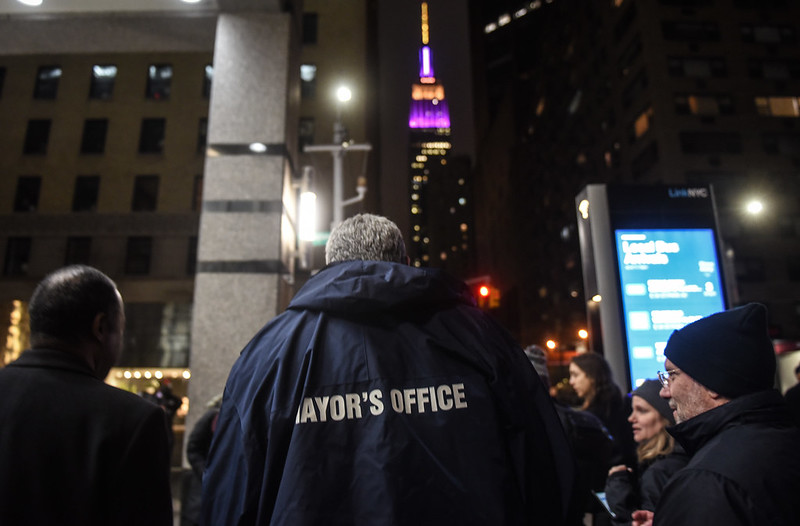
The mayor carrying out the HOPE count (photo: Michael Appleton/Mayor's Office)
It’s a shame that the city’s well-intentioned efforts to stop COVID-19 from spreading throughout homeless shelters turned negative so quickly. After relocating thousands of shelter residents into hotels on the Upper West Side and Midtown, Mayor Bill de Blasio is now reversing course in response to community uproar.
The mayor’s reversal is a stopgap measure, because the reality is that with a second wave of covid expected this fall, a similar drama will likely rear its head. So, how can we avoid repeating history?
The supportive housing model is the answer. While it currently exists in New York City, it must be greatly expanded.
First, it’s helpful for New Yorkers to understand the history of supportive housing as a model and how effective it can be in reducing homelessness and helping people—when it’s done right. The concept of supportive housing arose in the 1980s, following the deinstitutionalization of psychiatric care facilities and the turn to a more progressive policy model. After an era of warehousing homeless individuals facing mental health challenges, the supportive housing model offered an integrated mix of group transitional housing, greater independence, and access to health services. Importantly, the model linked shelter residents to dedicated community-based health facilities.
For example, one supportive housing organization, where I was general counsel, operated a community-based health clinic and a school-based health center that served our populations—including vulnerable kids and families and adults struggling with addiction and other mental health challenges. Without these dedicated providers, our residents would have fallen through the cracks of the mainstream health care system. I’ve seen many people’s lives transformed by how supportive housing allows for independence and the transition out of homelessness while providing a vital safety net along the way. And during a pandemic, linking homeless residents to health services is even more valuable to New Yorkers’ collective well-being.
When this model is successfully executed, it improves residential stability, reduces burdens on the most expensive public services, and offers a more cost-effective solution for the city—providing critical relief for our strained city finances. For example, homeless people with disabilities who move into supportive housing experience marked reductions in shelter use, hospitalizations, length of stay per hospitalization, and time incarcerated, resulting in a significant reduction in the cost of public services.
Second, for supportive housing to work, the communities home to these residents must feel that the model is safe and effective. When it comes to the Upper West Side and parts of Midtown, this has all been missing because homeless individuals have not been provided supportive housing, they've been placed in shelters without robust social services.
More supportive housing units must be brought online immediately.
Also important, the city must standardize its procedures for effectively dealing with the most troublesome residents who engage in criminal behavior or detract from the needs of other, more engaged residents, whether in typical shelters or supportive housing, which is permanent housing that includes social services targeted to residents' needs.
Those who don’t follow their program guidelines or engage in illegal behavior do more than simply disrupt the neighborhood’s enjoyment and safety—their behavior can create a cascading effect on other residents. And as we’ve seen in recent news coverage, a few bad apples can deeply damage the effectiveness of creating community-based solutions all over the city. In this case, bad press could have a lasting impact on shelter residents and others, putting them at increased risk of spreading COVID-19 beyond their immediate living quarters.
I’ve seen the many benefits that supportive housing has had in local neighborhoods and in the lives of the formerly homeless residents. One of the things that makes New York such an economic and cultural center is the fact that people of all backgrounds are able to live in the same communities. And stable housing for everyone makes our communities stronger, safer and more just.
As the homelessness crisis persists and the threat of a second covid wave looms, this is an issue in which every New Yorker has a stake, even if they do not yet know it. New York City has the infrastructure and expertise to be a national leader in this area. With more supportive housing options, thoughtful changes to the city’s policies, stronger leadership, and a more dedicated focus on neighborhood partnership, we can get this right. Our neighbors—all of them—deserve that.
***
Adam S. Herbst, Esq., is a health care administrator and an adjunct assistant professor at New York Law School, Columbia University's Mailman School of Public Health, and New York Medical College.
Note: this article has been corrected and updated to reflect that residents who have been living in shelters on the Upper West Side and Midtown that have garnered recent attention were not moved from supportive housing to those shelters.
***
Have an op-ed idea or submission for Gotham Gazette? Email This email address is being protected from spambots. You need JavaScript enabled to view it.




